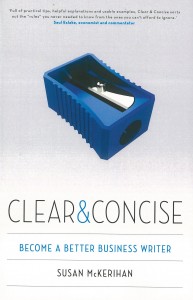 If you’ve spent much time within the contemporary business world, you’ve probably come across sentences like this one:
If you’ve spent much time within the contemporary business world, you’ve probably come across sentences like this one:
‘To minimise the amount of time devoted to consideration of operational issues and to performance monitoring, and thereby permit the maximum amount of time to be devoted to the Board’s other key role, consideration of strategic and policy issues, prior to each meeting, and in sufficient time (not less than ten working days) to enable the directors to give them due consideration, the Managing Director should distribute a memorandum outlining those issues deemed to be of relevance for discussion at such meeting.’
It’s the type of verbose, over-qualified language that people tend to adopt when writing about business. (And yes, that’s one sentence.) In her new book Clear & Concise: Become a better business writer, Plain English coach and consultant Susan McKerihan offers a series of tips and advice to combat it, for anyone writing anything in a business setting.
First up is set of guidelines about sentence structure, word choice and grammar, with plenty of examples. Some are the kinds of things you may have been taught once upon a time by a well-meaning English teacher, but never had enforced – punctuation 101, subject-verb agreement, and the difference between which and that. But McKerihan also explains plainly how things like nominalisation (burying the verb) and a lack of parallelism in lists cloud meaning and make the act of reading more difficult for the person who matters most – the reader.
It’s the third part of this book, ‘The big picture’, that distinguishes it from the style guide genre. Here, McKerihan spells out just why we tend to confuse style with substance so often when writing for business – we’ve been educated to write elaborately and have learnt from others to use big words to sound wiser, and also because the business environment isn’t conducive to drafting, editing and rewriting. She gives suggestions for improvement that are clear and non-patronising: know your reader and purpose, and use structure and layout to your advantage.
Some of the best tips are the most simple. Read aloud what you’ve written. Does it sound like how you would say it? If not, have another go. McKerihan cites the Australian Financial Review as a good place to go for examples of clear writing about business concepts.
She also calls on business writers to stop the vicious circle: ‘If more people have the confidence to write clearly and plainly, there will be more good practice examples circulating in the business community for others to learn from.’ Ultimately, Clear & Concise is a useful, easy and enjoyable read, and a recommended addition to any workplace bookshelf.
Susan McKerihan’s course An Introduction to Plain English is on Saturday, 20 June. More information here.
Jessica Surman is a writer of fiction, non-fiction and copy. She is an intern at the NSW Writers’ Centre. Follow her on Twitter @jesstrixie.
